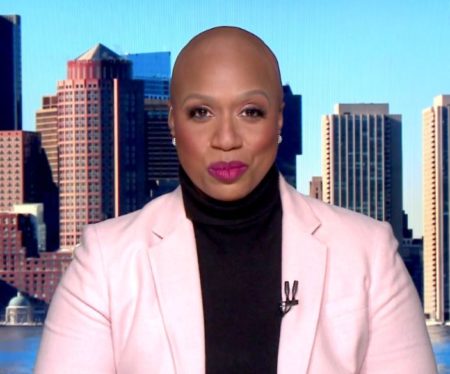Congresswoman Ayanna Pressley is just one of the millions of women that struggle with this form of severe hair loss.
Last week, Rep. Ayanna Pressley did an incredibly brave thing: She revealed to the world her battle with alopecia.
In an exclusive video for The Root, the freshman Democrat told the world that she has alopecia and showed off her beautiful bald head.
“In the fall, when I was getting my hair retwisted, is the first time that I was made aware that I had some patches,” Pressley said. “From there, it accelerated very quickly and got to the point” where she was “waking up every morning to sinkfuls of hair.”
“Every night I was employing all the tools that I had been schooled and trained in throughout my life as a black woman because I thought that I could stop this. I wrapped my hair. I wore a bonnet. I slept on a silk pillowcase,” she added.
“And yet and still every morning, which I faced with dread, I did not want to go to sleep because I did not want the morning to come where I would remove this bonnet and my wrap and be met with more hair in the sink and an image in the mirror of a person who increasingly felt like a stranger to me.”
I am awe of Pressley and am inspired by her courage.
But it’s important to point out that Rep. Pressley is not alone in this fight. It’s estimated that 40 percent of women over the age of 40 suffer from hair loss.
Here are five facts that every black woman needs to know:
1. Alopecia areata is an autoimmune disorder. One form of alopecia is alopecia areata, which is classified as an autoimmune disorder that attacks the hair follicles. This causes one’s hair to come out, often in clumps the size and shape of a quarter, according to WebMD. Folks with this disorder can have hair that falls out in patches or they can lose a lot of hair.
Alopecia areata is occasionally associated with other autoimmune conditions, such as thyroid disease, vitiligo, lupus, rheumatoid arthritis and ulcerative colitis, MedicineNet.com reported.
It’s unknown if this is the type of alopecia Jada Pinkett-Smith, who also recently revealed she’s suffering from hair loss, has. CNN noted the tests she took have yet to uncover a medical explanation for her hair loss. However, some of her friends believe her condition is due to stress.
2. Traction alopecia is more common among black women. Traction alopecia is the most common form of alopecia that affects black women. This type of hair loss is a result of the tension from our styles such as weaves, braids, extensions and wigs. It happens when the follicle is inflamed from the hair being pulled too tightly for too long. This hair loss can occur anywhere on the scalp, but we see it a lot on a woman’s hairline, the kitchen and from the front to behind our ears.
One important thing to keep in mind: Traction alopecia doesn’t happen overnight. As the New York Times pointed out, it comes in stages starting with pain and little bumps around the follicles, gradual thinning and then scarring causing permanent hair loss in that area.
Growing your hair back isn’t going to happen overnight either. Allure noted it can take three month to nine months to see any progress with treatment, which can include steroid shots, follicle serums, vitamins and growth cremes like Rogaine. So just be patient.
3. Loosen those braids, weaves and relaxers. In some cases, alopecia can be genetic, but for many black women, traction caused by how we style our hair seems to be a huge cause. So one way to prevent or alleviate hair loss can include the following:
- Make sure your braids aren’t so tight, especially around the hairline. Don’t be afraid to let the braider know you’re uncomfortable.
- If you can, stretch out your relaxers a bit or relax the areas where there is hair loss less often than the rest of your scalp.
- Keep in mind your protective style may not be protecting your hair. So pay attention.
- Work with your stylist on a hairdo that won’t make your hair loss worse.
4. Don’t forget about folliculitis-induced alopecia. This type of alopecia occurs when bacteria seeps down into the scalp, causing inflammation of the hair follicles. According to Live Strong, there are different forms of folliculitis, including non-infectious and infectious. It’s believed that non-infectious forms are caused by greases and oils that are applied to the scalp and clog the hair follicles. Treatment can include antibiotics and topical creams.
5. Early detection is best, so go to the dermatologist. Once the follicle is scarred, the damage is not reversible, so please make an appointment with a dermatologist or doctor as soon as you can. From there, they will diagnose the type of alopecia you have, ascertain the best course of treatment and, if possible, reverse any hair loss you’ve already suffered.
Remember, you don’t have to suffer in silence. Just be as proactive as you can.
—Kellee Terrell
From Hello Beautiful







